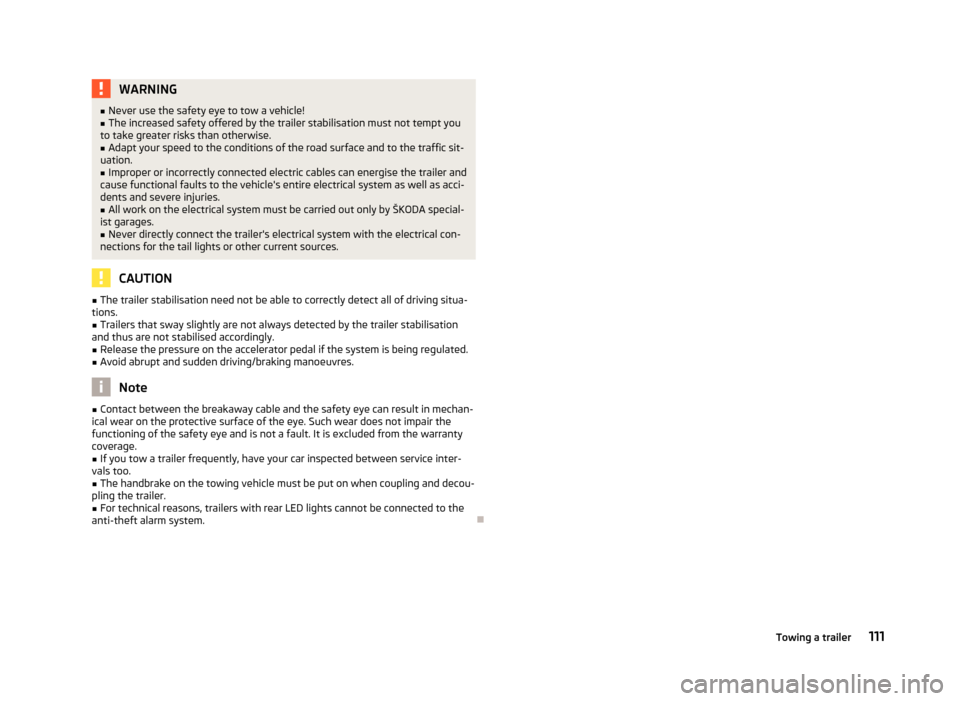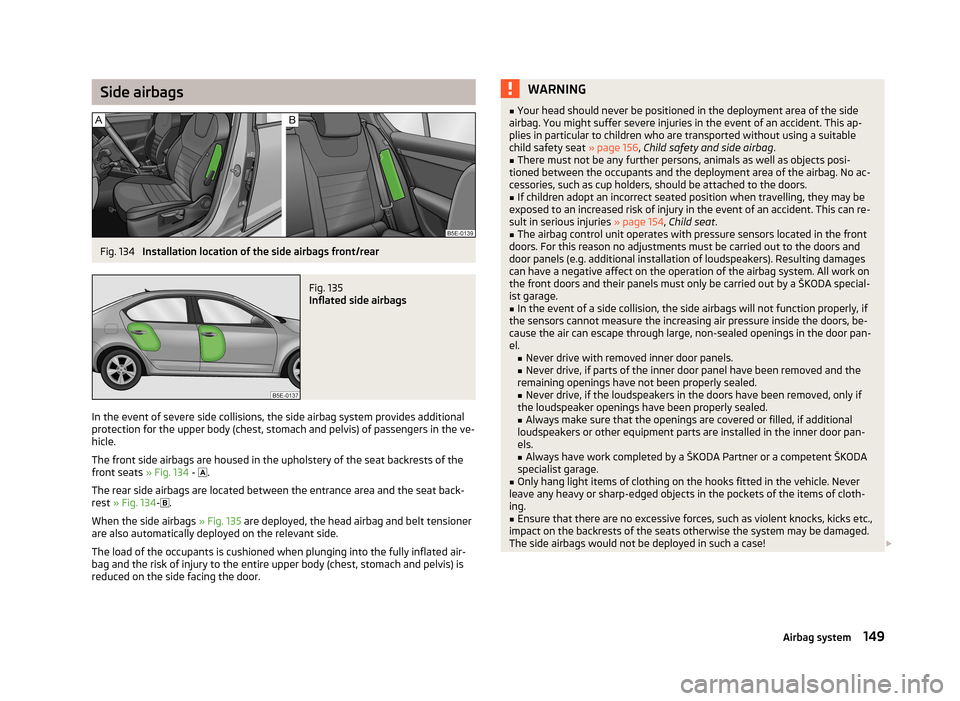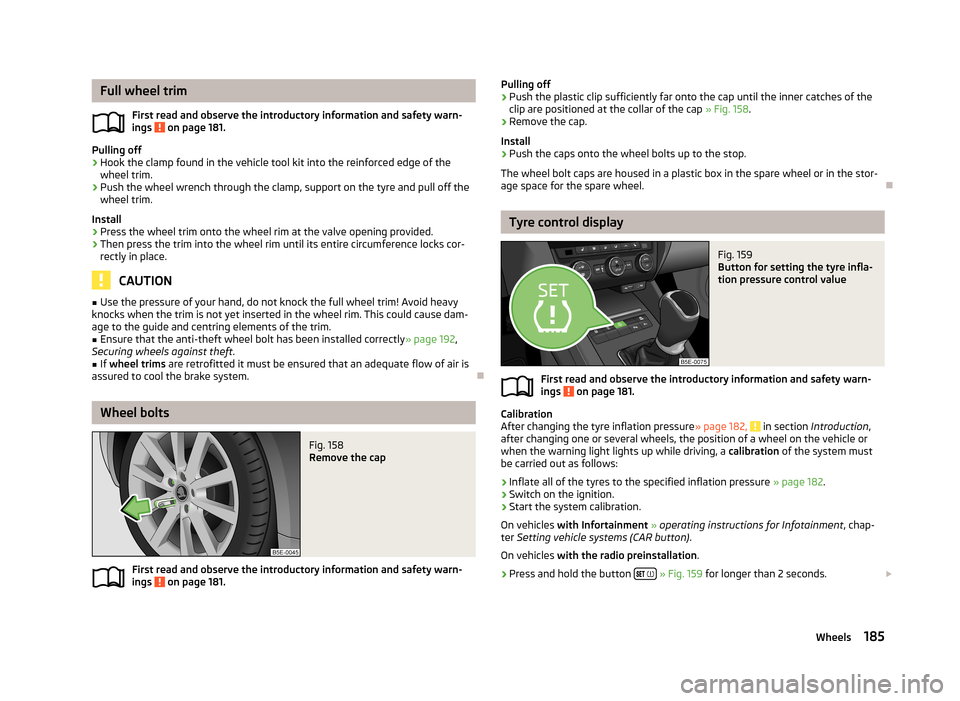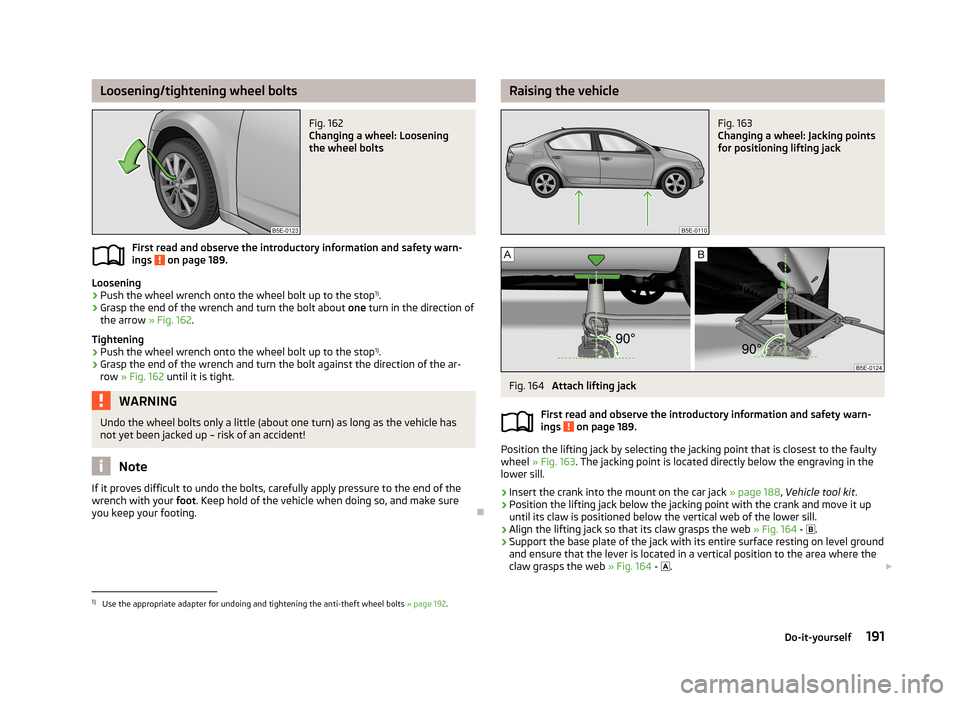tire pressure SKODA OCTAVIA 2012 3.G / (5E) Owner's Manual
[x] Cancel search | Manufacturer: SKODA, Model Year: 2012, Model line: OCTAVIA, Model: SKODA OCTAVIA 2012 3.G / (5E)Pages: 222, PDF Size: 13.52 MB
Page 113 of 222

WARNING■Never use the safety eye to tow a vehicle!■The increased safety offered by the trailer stabilisation must not tempt you
to take greater risks than otherwise.■
Adapt your speed to the conditions of the road surface and to the traffic sit-
uation.
■
Improper or incorrectly connected electric cables can energise the trailer and
cause functional faults to the vehicle's entire electrical system as well as acci-
dents and severe injuries.
■
All work on the electrical system must be carried out only by ŠKODA special-
ist garages.
■
Never directly connect the trailer's electrical system with the electrical con-
nections for the tail lights or other current sources.
CAUTION
■ The trailer stabilisation need not be able to correctly detect all of driving situa-
tions.■
Trailers that sway slightly are not always detected by the trailer stabilisation
and thus are not stabilised accordingly.
■
Release the pressure on the accelerator pedal if the system is being regulated.
■
Avoid abrupt and sudden driving/braking manoeuvres.
Note
■ Contact between the breakaway cable and the safety eye can result in mechan-
ical wear on the protective surface of the eye. Such wear does not impair the
functioning of the safety eye and is not a fault. It is excluded from the warranty
coverage.■
If you tow a trailer frequently, have your car inspected between service inter-
vals too.
■
The handbrake on the towing vehicle must be put on when coupling and decou-
pling the trailer.
■
For technical reasons, trailers with rear LED lights cannot be connected to the
anti-theft alarm system.
111Towing a trailer
Page 151 of 222

Side airbagsFig. 134
Installation location of the side airbags front/rear
Fig. 135
Inflated side airbags
In the event of severe side collisions, the side airbag system provides additional
protection for the upper body (chest, stomach and pelvis) of passengers in the ve-
hicle.
The front side airbags are housed in the upholstery of the seat backrests of the front seats » Fig. 134 -
.
The rear side airbags are located between the entrance area and the seat back-
rest » Fig. 134 -
.
When the side airbags » Fig. 135 are deployed, the head airbag and belt tensioner
are also automatically deployed on the relevant side.
The load of the occupants is cushioned when plunging into the fully inflated air-
bag and the risk of injury to the entire upper body (chest, stomach and pelvis) is
reduced on the side facing the door.
WARNING■ Your head should never be positioned in the deployment area of the side
airbag. You might suffer severe injuries in the event of an accident. This ap- plies in particular to children who are transported without using a suitable
child safety seat » page 156, Child safety and side airbag .■
There must not be any further persons, animals as well as objects posi-
tioned between the occupants and the deployment area of the airbag. No ac-
cessories, such as cup holders, should be attached to the doors.
■
If children adopt an incorrect seated position when travelling, they may be
exposed to an increased risk of injury in the event of an accident. This can re-
sult in serious injuries » page 154, Child seat .
■
The airbag control unit operates with pressure sensors located in the front
doors. For this reason no adjustments must be carried out to the doors and
door panels (e.g. additional installation of loudspeakers). Resulting damages
can have a negative affect on the operation of the airbag system. All work on
the front doors and their panels must only be carried out by a ŠKODA special-
ist garage.
■
In the event of a side collision, the side airbags will not function properly, if
the sensors cannot measure the increasing air pressure inside the doors, be-
cause the air can escape through large, non-sealed openings in the door pan-
el. ■ Never drive with removed inner door panels.
■ Never drive, if parts of the inner door panel have been removed and the
remaining openings have not been properly sealed.
■ Never drive, if the loudspeakers in the doors have been removed, only if
the loudspeaker openings have been properly sealed. ■ Always make sure that the openings are covered or filled, if additional
loudspeakers or other equipment parts are installed in the inner door pan- els.
■ Always have work completed by a ŠKODA Partner or a competent ŠKODA
specialist garage.
■
Only hang light items of clothing on the hooks fitted in the vehicle. Never
leave any heavy or sharp-edged objects in the pockets of the items of cloth-
ing.
■
Ensure that there are no excessive forces, such as violent knocks, kicks etc.,
impact on the backrests of the seats otherwise the system may be damaged.
The side airbags would not be deployed in such a case!
149Airbag system
Page 187 of 222

Full wheel trimFirst read and observe the introductory information and safety warn-
ings
on page 181.
Pulling off
›
Hook the clamp found in the vehicle tool kit into the reinforced edge of the wheel trim.
›
Push the wheel wrench through the clamp, support on the tyre and pull off the
wheel trim.
Install
›
Press the wheel trim onto the wheel rim at the valve opening provided.
›
Then press the trim into the wheel rim until its entire circumference locks cor- rectly in place.
CAUTION
■ Use the pressure of your hand, do not knock the full wheel trim! Avoid heavy
knocks when the trim is not yet inserted in the wheel rim. This could cause dam-
age to the guide and centring elements of the trim.■
Ensure that the anti-theft wheel bolt has been installed correctly » page 192,
Securing wheels against theft .
■
If wheel trims are retrofitted it must be ensured that an adequate flow of air is
assured to cool the brake system.
Wheel bolts
Fig. 158
Remove the cap
First read and observe the introductory information and safety warn- ings on page 181.
Pulling off›Push the plastic clip sufficiently far onto the cap until the inner catches of the
clip are positioned at the collar of the cap » Fig. 158.›
Remove the cap.
Install
›
Push the caps onto the wheel bolts up to the stop.
The wheel bolt caps are housed in a plastic box in the spare wheel or in the stor-
age space for the spare wheel.
Tyre control display
Fig. 159
Button for setting the tyre infla-
tion pressure control value
First read and observe the introductory information and safety warn-
ings on page 181.
Calibration
After changing the tyre inflation pressure » page 182, in section Introduction ,
after changing one or several wheels, the position of a wheel on the vehicle or
when the warning light lights up while driving, a calibration of the system must
be carried out as follows:
›
Inflate all of the tyres to the specified inflation pressure » page 182.
›
Switch on the ignition.
›
Start the system calibration.
On vehicles with Infortainment » operating instructions for Infotainment , chap-
ter Setting vehicle systems (CAR button) .
On vehicles with the radio preinstallation .
›
Press and hold the button
» Fig. 159 for longer than 2 seconds.
185Wheels
Page 193 of 222

Loosening/tightening wheel boltsFig. 162
Changing a wheel: Loosening
the wheel bolts
First read and observe the introductory information and safety warn-
ings on page 189.
Loosening
›
Push the wheel wrench onto the wheel bolt up to the stop 1)
.
›
Grasp the end of the wrench and turn the bolt about one turn in the direction of
the arrow » Fig. 162.
Tightening
›
Push the wheel wrench onto the wheel bolt up to the stop 1)
.
›
Grasp the end of the wrench and turn the bolt against the direction of the ar-
row » Fig. 162 until it is tight.
WARNINGUndo the wheel bolts only a little (about one turn) as long as the vehicle has
not yet been jacked up – risk of an accident!
Note
If it proves difficult to undo the bolts, carefully apply pressure to the end of the
wrench with your foot. Keep hold of the vehicle when doing so, and make sure
you keep your footing.
Raising the vehicleFig. 163
Changing a wheel: Jacking points
for positioning lifting jack
Fig. 164
Attach lifting jack
First read and observe the introductory information and safety warn-
ings
on page 189.
Position the lifting jack by selecting the jacking point that is closest to the faulty
wheel » Fig. 163 . The jacking point is located directly below the engraving in the
lower sill.
›
Insert the crank into the mount on the car jack » page 188, Vehicle tool kit .
›
Position the lifting jack below the jacking point with the crank and move it up
until its claw is positioned below the vertical web of the lower sill.
›
Align the lifting jack so that its claw grasps the web » Fig. 164 -
.
›
Support the base plate of the jack with its entire surface resting on level ground
and ensure that the lever is located in a vertical position to the area where the
claw grasps the web » Fig. 164 -
.
1)
Use the appropriate adapter for undoing and tightening the anti-theft wheel bolts
» page 192.
191Do-it-yourself